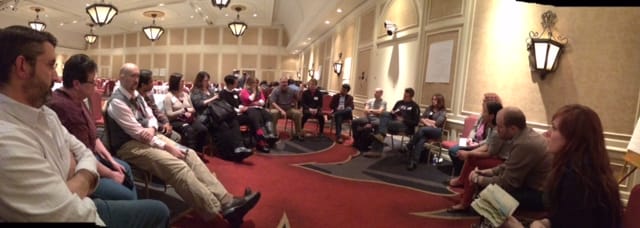Agile Day Twin Cities

The annual Agile Day Twin Cities conference was held in St. Paul yesterday. As always, the community here in the Twin Cities really made this event what it was.
One of the things I like best about this conference is that it is a huge conversation starter for pretty much any topic you want to talk about. The first half (just like last year) was reserved for 45 minute presentations on various topics in the agile space. These presentations seed the afternoon with ideas for conversation. The second half of the day was reserved for attendees to talk and learn from each other. This was organized as an open space, with attendees suggesting topics and facilitating discussions of their own.
Focusing on Outcome
One of the open sessions I attended in the afternoon was about focusing on outcome. It was a topic suggested by a friend who frequently gets the request “just build this for us. we need it.” We get this request all the time.
- “Mom, can you tie my shoes?”
- “Dad, can you fix my snowblower again?”
- “Can you just add this button here on this screen?”
It’s the request that is focused on a solution, rather than figuring out what the real problem is. We talked about how to have better conversations with coworkers about this, metaphors and language we can use to make it more productive.
Doctor vs. Waiter
One metaphor that we were reminded of was from last year’s Agile Day: the doctor vs. waiter role. Are you a waiter, taking orders and blindly serving up solutions for your customers? Or are you a doctor, looking for the root of the problem and helping your customer solve their actual (instead of perceived) problems? I think we frequently run into waiters even in our professional lives where we are not in the food industry. We are thought workers and problem solvers. We should not be, nor do we want to be, handed a solution on a silver platter. If we put even a little thought into the problem we are trying to solve rather than jumping right into the solution, we might find that a) we don’t even know what the problem is or b) our solution doesn’t actually solve a real problem.
But how do we go about being “doctors” and encouraging people to act in a “doctor” role?
The Five Whys
What if we employ the Five Whys?
Customer: “Can you just add this button here on this screen?”
Me: “Why do you need a button there?”
Customer: “So I just have to click it to sum up my data?”
Me: “Why do you need to sum up the data?”
Customer: “So I can report it back to my manager every day.”
Me: “Why do you need to report it to your manager?”
Customer: “So my manager can report it back to her manager.”
Me: “Why does your manager’s manager need this data?”
Customer: “Because sometimes my manager’s manager wants to know how much we spent on these widgets.”
Me: “Why only sometimes?”
Customer: “Because sometimes our client wants to know.”
So really, my customer does not need a button to click to sum up data. At the root of the issue, my customer’s client needs some information only sometimes. At this point, we might actually solve this problem with providing a way for the client to run a report on their own schedule rather than a nasty button on some screen. We’ve not even dived into why the client sometimes need this data or what they are going to do with it. So what if the client uses this data to determine how and when to market these new widgets to their customers? Our nasty button really isn’t going to do us or our customer any good.
This conversation focused on outcome. It focused on what the problem was that we needed to solve rather than just blindly implementing a solution. By asking the Five Whys, we can drive out the root problem so that we can focus on outcome. It is a simple way to take on a doctor role, instead of a waiter role.
Continuing to Learn
Unfortunately, I think we also need to feel confident and empowered to ask questions. Questioning like this, especially if it’s not common practice or not something you are used to doing, can be difficult to do without alienating the people around you. Sometimes you have to just push through while having an open conversation about it. It might be difficult at first. But the sooner you rip off the band-aid, the sooner you are going to learn more about your customers and their needs.